Metallic material
Innovation | Professionalism
Integrity | Efficiency
Metallic material
Innovation | Professionalism
Integrity | Efficiency
Aluminum is a popular metal because of its lightweight, corrosion-resistant and conductive properties. Aluminum alloys, in particular, are used in a wide variety of industries including aerospace, automotive, construction and electronics. Aluminum alloys are made by combining aluminum with other metals to improve its properties. However, not all aluminum alloys are created equal, and understanding the different types of aluminum alloys and their classifications is critical to choosing the right alloy for a particular application.
The following is a breakdown of major Aluminum Alloy categories and their classifications:
1xxx Series: These are the purest form of aluminum and contain at least 99% aluminum. They are very soft, malleable and have excellent corrosion resistance, making them suitable for applications such as packaging, electrical conductors and heat exchangers.
2xxx Series: These alloys contain copper as the main alloying element and provide high strength and excellent fatigue resistance. They are commonly used in aerospace and military applications.
3xxx Series: These alloys contain manganese as the primary alloying element and provide good strength and corrosion resistance. They are commonly used in roofing, siding and gutters in the construction industry.
4xxx series: These alloys contain silicon as the main alloying element and have good fluidity and corrosion resistance. They are commonly used for welding and brazing.
5xxx Series: These alloys contain magnesium as the main alloying element and have good formability, weldability and corrosion resistance. They are commonly used in the automotive and marine industries.
6xxx Series: These alloys contain magnesium and silicon as the main alloying elements and provide good strength, weldability, and corrosion resistance. They are commonly used for structural components in the construction industry and automotive frames and railcars in the transportation industry.
7xxx Series: These alloys contain zinc as the main alloying element and have very high strength and excellent fatigue resistance. They are commonly used in aerospace applications and the construction of high performance sports equipment.
In addition to the classification system developed by the Aluminum Association, there are international standards for aluminum alloys developed by the International Organization for Standardization (ISO) and the European Committee for Standardization (CEN).
In conclusion, understanding the different types of aluminum alloys and their classifications is important in selecting the appropriate alloy for a particular application. Each alloy has unique properties and characteristics that make it suitable for specific industries and applications.
1. Lightweight and high-strength: Aluminum has a low density, only about one third of steel, but its tensile strength is higher than steel. Therefore, aluminum is lighter than steel at the same strength.
2. Corrosion resistance: Aluminum has good corrosion resistance, and can form a very thin oxide film in the air to prevent further oxidation reaction, so that the surface of aluminum has good corrosion resistance.
3. Good thermal conductivity and electrical conductivity: Aluminum is a good electrical and thermal conductivity material, and its density is lighter than that of copper, so it can manufacture smaller radiators, and it can also be widely used in fields that require high electrical and thermal conductivity.
4. Strong machinability: Aluminum can be processed into complex shapes through various processing methods, such as extrusion, stretching, rolling, stamping, drilling, etc., to manufacture products of various shapes and specifications.
5. Good plasticity: Aluminum has good plasticity, and various shapes of aluminum products can be manufactured under hot and cold working conditions.
6. Environmental protection: Aluminum can be recycled and reused to reduce resource waste and environmental pollution, and has good environmental protection performance.
The production of aluminum is mainly realized by electrolysis. The following is the general aluminum production process:
Mining and processing of aluminum ore: Aluminum ore is mainly composed of muscovite, quartz, feldspar and other minerals, which need to be crushed, ground and soaked to obtain alumina (Al2O3).
Reduction of alumina: After mixing alumina and a certain amount of graphite powder, it is reduced to aluminum at high temperature.
Aluminum production by electrolysis: the reduced aluminum is placed in an electrolytic cell, and aluminum ions are precipitated in the electrolyte by the action of an electric current, finally forming aluminum metal. At the same time, alumina will also be reduced to oxygen and released during the electrolysis process.
Aluminum refining and product processing: refining the obtained aluminum to remove impurities such as impurities and air bubbles, and then perform product processing according to needs, such as extrusion, stretching, rolling, stamping, welding, etc., into various specifications and shapes of aluminum, aluminum alloys and aluminum products.
Aluminum is a lightweight, corrosion-resistant, and thermally conductive metal, so it has a wide range of applications in many fields. The following are some of the main application areas of aluminum:
Construction and building materials: aluminum alloy profiles, aluminum film, aluminum alloy doors and windows, aluminum alloy roofs, aluminum plates, etc.
Transportation: Manufacturing and decoration of various vehicles such as automobiles, trains, aviation, ships, etc., such as automobile frames, engine covers, doors, hulls, etc.
Packaging: aluminum foil, aluminum cans, aluminum lids and other packaging materials for food, medicine, cosmetics and other products.
Electronic products: aluminum casings, heat sinks, connectors, etc. in electronic products such as mobile phones, tablet computers, TVs, and computers.
Food processing: making kitchen utensils, food processing equipment, etc.
Energy: Aluminum can be used in the manufacture of solar panels, as well as high-voltage poles for transmitting electricity, etc.
The price of aluminum and aluminum alloys in the metal industry
The price of aluminum and aluminum alloys is usually affected by many factors, such as the price of aluminum raw materials, production costs, supply and demand, international trade policies and so on. Accordingly, the price of aluminum and aluminum alloys may fluctuate over time and as market conditions change.
Generally speaking, the price of aluminum is relatively low, but it will vary due to different uses and processing methods. For example, the price of aluminum sheet is usually higher than that of aluminum rod, while the price of processed aluminum alloy products is higher.
The price of aluminum alloy is usually higher than that of pure aluminum, because aluminum alloy has better strength, hardness and corrosion resistance. The prices of different types of aluminum alloys will also vary. For example, the prices of commonly used 6061 aluminum alloys and 7075 aluminum alloys are usually slightly higher than other types of aluminum alloys.
It should be noted that the above prices are for reference only, and the actual prices will vary according to market conditions and specific needs.
The front suspension to front frame crossmember link is a component in a vehicle's suspension system that connects the front suspension to the front frame crossmember. It is typically a metal rod or bar that is designed to provide stability and support to the suspension system by connecting it to the vehicle's frame.

Low carbon steel is often strengthened by the addition of microalloying elements such as niobium, titanium, and vanadium, which can be used alone or in combination to create carbonitride particles. These particles precipitate within the steel, providing strength, while also refining the grain structure to further enhance strength. Additionally, this type of steel exhibits excellent weldability. Its structure consists primarily of ferrite, with a minor presence of carbides.
| Grade | YS(MPa) | TS(MPa) | EL(%) | r | n | BH2(MPa) |
| HC340LAD+Z | 340-420 | 410-510 | ≥21% | - | - | - |
Grade: HC340LAD+Z
C(max): 0.11
Mn(max): 1
Si(max): 0.5


High-strength carbon structural steel is a steel variety that achieves superior strength by incorporating small amounts of alloy elements such as silicon and manganese, which primarily work through solid solution strengthening. The steel's primary structure is a combination of ferrite and pearlite.
Our company: Hengqiao(Shanghai) International Trading Limited
The company's main business is general GMW standard, Fiat EFE standard, Volvo VDA standard, Nissan NEN standard, Volkswagen VW50065, Ford WSS-M and other standard series of automotive steel.
Looking forward to your inquiry!
The roof panel is the outermost layer of the roof structure of a vehicle, typically made from automotive-grade steel. The roof panel serves as both a structural element of the vehicle and as protection for the vehicle's occupants from external elements such as rain, wind, and debris.
The roof panel is typically formed using a stamping process, where a sheet of steel is pressed into shape using a series of dies. The process can involve several steps to achieve the final shape and size required for the vehicle.

Dual phase steel is a popular choice for automotive structural components because of its unique microstructure consisting primarily of ferrite and martensite. The martensite structure is distributed in the form of islands within the ferrite matrix. This steel exhibits excellent mechanical properties such as high work hardening index, bake hardening value, and low yield ratio.
| Grade | YS(MPa) | TS(MPa) | EL(%) | r | n | BH2(MPa) |
| HC300/500DPD+Z | 290-370 | ≥500 | ≥27% | - | ≥0.15 | - |
Grade: HC300/500DPD+Z
C(max): 0.15
Mn(max): 2.5
Si(max): 0.6

The front header beam, also known as the front header panel, is a structural component of the roof system of a vehicle. It is typically located at the front of the roof structure, just above the windshield, and connects the roof rails or pillars to the vehicle's A-pillars.The front header beam plays a critical role in providing structural support and stability to the vehicle's roof system. The front header beam is usually made from high-strength steel, which provides the necessary strength and durability to withstand the forces generated during a collision. In some cases, the front header beam may also incorporate other materials, such as aluminum or composite materials, to help reduce the overall weight of the vehicle.

The rear header beam, also known as the rear header panel, is a structural component of the roof system of a vehicle. It is typically located at the rear of the roof structure, just above the rear windshield, and connects the roof rails or pillars to the vehicle's C-pillars.Similar to the front header beam, the rear header beam plays a critical role in providing structural support and stability to the vehicle's roof system. The rear header beam is usually made from high-strength steel, which provides the necessary strength and durability to withstand the forces generated during a collision.
Dual phase steel is a popular material for automotive structural components due to its unique microstructure consisting of ferrite and martensite. The martensite structure is dispersed throughout the ferrite matrix in island-like formations. This steel exhibits a low yield ratio, high work hardening index, and bake hardening value, making it a preferred choice for automotive applications.
| Grade | YS(MPa) | TS(MPa) | EL(%) | r | n | BH2(MPa) |
| HC340/590DPD+Z | 290-370 | ≥500 | ≥27% | - | ≥0.15 | - |
Grade: HC340/590DPD+Z
C(max): 0.15
Mn(max): 2.5
Si(max): 0.6


Low carbon steel is strengthened by the addition of microalloying elements, either individually or in combination, such as niobium, titanium, and vanadium. These elements form carbonitride particles that help to precipitate and reinforce the steel. Additionally, the microalloying elements also aid in refining the grain structure of the steel, leading to even greater strength. This type of steel also exhibits good weldability and consists primarily of a ferrite structure with a small amount of carbide.
| Grade | YS(MPa) | TS(MPa) | EL(%) | r | n | BH2(MPa) |
| HC340LA | 340-420 | 410-510 | ≥21% | - | ≥0.12 | - |
Grade: HC340LA
C(max): 0.12
Mn(max): 1.5
Si(max): 0.5
Our company: Hengqiao(Shanghai) International Trading Limited
The company's main business is general GMW standard, Fiat EFE standard, Volvo VDA standard, Nissan NEN standard, Volkswagen VW50065, Ford WSS-M and other standard series of automotive steel.
Looking forward to your inquiry!
The heat treatment process involves heating and cooling metal materials in order to modify their physical and mechanical properties. By changing the metal's crystal structure, it is possible to improve hardness, strength, toughness, corrosion resistance, wear resistance and other characteristics. The material must be heated to a required temperature and kept at that temperature for a certain amount of time before cooling in order to facilitate interior structural alterations. There are various methods of heat treatment based on the metal material and application - processes such as quenching, tempering, normalizing, annealing and aging can be used to enhance desirable features.
The basic steps of the heat treatment process usually include the following stages:
Heating: Heating a metallic material to a temperature that can be above or below the melting point of the material, depending on the desired heat treatment process and the nature of the metal. Heating methods usually include stove heating, induction heating, resistance heating, etc.
Insulation: After reaching the required temperature, the metal material needs to be kept at this temperature for a certain period of time to allow the internal structure of the material to change. The length of holding time depends on factors such as the type, shape and size of the material.
Cooling: After the holding time is over, the metallic material needs to be cooled rapidly to solidify its new structure. The cooling method can be water quenching, oil quenching, air cooling, etc. Different cooling methods can affect the properties and hardness of the material.
The heat treatment temperature is determined by the required heat treatment process and the properties of the metal material. Different metal materials and heat treatment processes require different temperature ranges.
Taking steel as an example, the commonly used heat treatment temperature ranges from 400°C to 1200°C. The exact temperature depends on the desired heat treatment process and the composition of the steel. For example, quenching requires heating the steel to between 800°C and 1000°C, and tempering requires heating the steel to between 300°C and 700°C after quenching.
Other metal materials also need to determine the most suitable heat treatment temperature according to their properties and required heat treatment process.
The main purpose of heat treatment is to change the structure and properties of metallic materials by heating and cooling them, so as to obtain the desired material properties. Different heat treatment processes can produce different effects, such as improving the hardness, strength, toughness, wear resistance, corrosion resistance and so on of the material.
Generally, heat treatment can be divided into two types: tempering and quenching. Tempering is to heat the metal material to a certain temperature and then cool it slowly to reduce the stress inside the material and improve its toughness; while quenching is to heat the metal material to a high temperature and then cool it rapidly to increase the hardness and strength of the material.
In addition to tempering and quenching, there are other heat treatment processes, such as annealing, normalizing, surface hardening and so on. Each heat treatment process has its unique advantages and scope of application, and the appropriate heat treatment process can be selected according to specific application requirements.
Heat treatment processes can be divided into many types, each with its own unique scope of application and purpose. The following are several common heat treatment processes:
Tempering: Heating the quenched metal material to a certain temperature and then cooling it slowly to reduce the stress inside the material and improve its toughness.
Quenching: Heating a metal material to a high temperature and then cooling it rapidly to increase the hardness and strength of the material.
Annealing: Heating a metal material to a certain temperature and then cooling it slowly to improve its internal structure and increase its toughness.
Normalizing: Heating a metal material to a certain temperature and then cooling it to room temperature in order to improve the structure of the material and increase its strength.
Quenching and tempering (Quench and Tempering): Quenching the metal material first and then tempering it to improve its hardness and strength while maintaining its good toughness.
Surface Hardening: Form a hardened layer on the surface of metal materials to improve its surface hardness and wear resistance. Common surface hardening methods include gas carburizing, ion carburizing, and nitriding.
1.Quenching: The quenching of steel is to heat the steel to a temperature above the critical temperature Ac3 (hypoeutectoid steel) or Ac1 (hypereutectoid steel), keep it warm for a period of time to make it austenitized in whole or in part, and then austenitize it with a temperature greater than the critical temperature. A heat treatment process in which the cooling rate is quickly cooled to below Ms (or isothermal near Ms) for martensite (or bainite) transformation.
Application range: quenching process is the most widely used, such as tools, measuring tools, molds, bearings, springs and automobiles, tractors, diesel engines, cutting machine tools, pneumatic tools, drilling machinery, agricultural machinery, petroleum machinery, chemical machinery, textile machinery, aircraft, etc. Parts are using quenching process.
2.Tempering process
Tempering is a heat treatment process that reheats the quenched workpiece to an appropriate temperature lower than the lower critical temperature, and then cools it to room temperature in air, water, oil and other media after holding it for a period of time.
The purpose of tempering: (1) Eliminate the residual stress generated when the workpiece is quenched to prevent deformation and cracking; (2) Adjust the hardness, strength, plasticity and toughness of the workpiece to meet the performance requirements; (3) Stabilize the structure and size to ensure Accuracy; (4) Improve and enhance processing performance.
3.Normalizing process
Normalizing is a metal heat treatment process in which the steel is heated to 30-50°C above the critical temperature (full austenitization temperature), and after holding for a proper time, it is taken out of the furnace and cooled in the air or sprayed with water, sprayed or blown.
Purpose: (1) to refine grains and homogenize carbide distribution; (2) to remove internal stress of the material; (3) to increase the hardness of the material.
4.Annealing process
The material is heated to a specific temperature and held for a period of time, and then cooled slowly to soften the material, reduce internal stress, and improve cutting performance. The essence of annealing is to heat the steel to austenitize and undergo pearlite transformation, and the structure after annealing is close to the equilibrium structure.
Purpose of annealing:
(1) Reduce the hardness of steel, improve plasticity, and facilitate machining and cold deformation processing;
(2) Homogenize the chemical composition and structure of the steel, refine the grain, improve the performance of the steel or prepare the structure for quenching;
(3) Eliminate internal stress and work hardening to prevent deformation and cracking.
The rear parcel shelf, also known as the rear package tray, is a flat panel located above the rear seats in a car's cabin. It is designed to provide a platform for storing small items such as books, bags, and other lightweight objects. The rear parcel shelf also serves as a cover for the trunk area, providing an added level of security and privacy for items stored in the back of the vehicle.

Steel contains a certain amount of carbon and nitrogen atoms in solid solution, which can be strengthened by adding elements like phosphorus and manganese. Age hardening further increases the yield strength of the steel after processing, forming, and baking at a specific temperature. This type of steel is commonly utilized in automotive body panels and has a ferrite microstructure.
| Grade | YS(MPa) | TS(MPa) | EL(%) | r | n | BH2(MPa) |
| HC180BD+Z | 180-340 | 300-600 | ≥34% | ≥1.5 | ≥0.16 | ≥30 |
Grade: HC180BD+Z
C(max): 0.04
Mn(max): 1
Si(max): 0.5
The rear parcel shelf front crossmember is a horizontal beam that connects the two sides of the rear parcel shelf in a car's cabin. It is usually made of metal and located within the frame structure beneath the rear seats. The front crossmember provides additional strength and stability to support the items stored on the rear parcel shelf. The design and material of the crossmember may vary depending on the make and model of the car, and it is an important component for the overall structural integrity of the rear parcel shelf.

High-strength carbon structural steel is a variety of steel that achieves elevated strength levels by incorporating small amounts of alloying elements such as silicon and manganese, primarily through solid solution strengthening. The primary microstructure of this steel is composed of ferrite and pearlite.
Our company: Hengqiao(Shanghai) International Trading Limited
The company's main business is general GMW standard, Fiat EFE standard, Volvo VDA standard, Nissan NEN standard, Volkswagen VW50065, Ford WSS-M and other standard series of automotive steel.
Looking forward to your inquiry!
Upper A-pillar Reinforcement is a steel plate used to strengthen the upper structure of the A-pillar of a car. It is usually installed inside the A-pillar and close to the surface of the A-pillar to enhance the rigidity and safety performance of the car body.
The A-pillar is an important part of the body structure, responsible for supporting the connection between the roof and the frame, and protecting the driver and passengers in the event of a side collision. On the upper part of the A-pillar, due to the load of the roof and the influence of the height and weight of the vehicle body, it is easy to bend or deform. Therefore, it is necessary to install Upper A-pillar Reinforcement to enhance the rigidity and stability of the A-pillar to improve The overall strength and crash safety performance of the car body.
Usually, Upper A-pillar Reinforcement is made of high-strength steel sheet, which can be designed and customized according to different models and requirements. Where and how it is installed may vary by model and manufacturer, but in general, it is an important safety component that plays an important role in improving the safety performance of the car.

The process of producing hot-formed steel involves heating the billet to a temperature above its austenitization point, maintaining it at that temperature for a specific duration, and then subjecting it to a press and quench method to create a martensitic structure. This process results in parts with exceptional strength and toughness, which in turn enhances their resistance to collisions. Hot-formed steel is particularly useful in the manufacture of body structural parts, especially those designed for intrusion-proof security purposes.
The Upper Reinforcement Panel is a steel panel used to strengthen the car body structure, usually above the roof, to enhance the rigidity and torsional performance of the car body.
The upper beam in the car body structure is a structural member connecting the left and right B-pillars, responsible for supporting the connection between the roof and the bottom of the body, and bearing the weight of the body and external impact. However, when driving at high speed or in a collision, the upper part of the vehicle body will be affected by twisting force. It is necessary to install a side sill reinforcement plate to increase the rigidity and torsion resistance of the vehicle body to ensure the stability and driving safety of the vehicle.
The Upper Reinforcement Panel is usually made of high-strength steel plates. Its design and installation location may vary depending on the model and manufacturer, but it is usually close to the roof, connected to the upper part of the B-pillar from the left and right sides, and connected to the A , C-pillar and other structural parts are connected together to form an integral body structure.

Dual-phase steel is characterized by a microstructure consisting mainly of ferrite and martensite. The martensite structure is distributed throughout the ferrite matrix in the form of islands. This unique structure provides the steel with a low yield ratio, a high work hardening index, and a bake hardening value, making it an ideal material for automotive structural parts. Due to its exceptional properties, which allow for increased strength and durability in structural components.
| Grade | YS(MPa) | TS(MPa) | EL(%) | r | n | BH2(MPa) |
| HC550/980DPD+Z | 550-730 | ≥980 | ≥10% | - | - | - |
Grade: HC550/980DPD+Z
C(max): 0.23
Mn(max): 3
Si(max): 1
Rocker Panel Reinforcement is a type of steel plate or beam used to reinforce the rocker panel area of a vehicle. The rocker panel is the area between the front and rear wheel wells along the lower edge of the vehicle's body, and it is susceptible to damage from debris or impact during normal driving.
The purpose of the Rocker Panel Reinforcement is to provide additional support and strength to this area of the vehicle's body, which is critical for maintaining the vehicle's structural integrity and safety in the event of a collision. The reinforcement is typically made of high-strength steel and is designed to fit snugly against the rocker panel, providing an additional layer of protection against damage.

Q&P steel is a type of steel that contains martensite as well as a significant amount of ferrite, and approximately 8% to 12% retained austenite. This steel is notable for utilizing the transformation-induced plasticity effect of retained austenite during deformation, which enables it to achieve higher levels of work hardening performance and elongation. Compared to high-strength steel of a similar strength level, Q&P steel offers superior plasticity and formability. This makes it an ideal choice for applications that require a balance between strength and ductility.
| Grade | YS(MPa) | TS(MPa) | EL(%) | r | n | BH2(MPa) |
| HC820/1180QPD+Z | 820-1100 | ≥1180 | ≥8% | - | - | - |
Grade: HC820/1180QPD+Z
C(max): 0.25
Mn(max): 3
Si(max): 2.5
Lower A-pillar Reinforcement is a steel plate or beam that is installed in the lower section of the A-pillar of a vehicle's body structure. The A-pillar is the vertical support that connects the front of the vehicle's roof to its body, and it is a critical component of the vehicle's safety structure.
In the event of a frontal collision, the A-pillar is subjected to significant forces that can cause it to deform or collapse, compromising the structural integrity of the vehicle and increasing the risk of injury to the occupants. The Lower A-pillar Reinforcement is designed to provide additional support and strength to this critical area of the vehicle's body structure, helping to distribute the impact forces more effectively and reducing the risk of deformation or collapse.

Hot-formed steel is produced by heating a billet above its austenitization temperature, holding it for a specific duration, and then rapidly quenching it to create a martensitic structure. This process results in parts that are characterized by high strength and toughness, which greatly enhances their anti-collision performance. Hot-formed steel is typically utilized in the manufacture of body structural parts, particularly those intended for intrusion-proof security purposes.
B-Pillar Reinforcement is a structural component of a vehicle's body that is designed to increase the strength and rigidity of the B-pillar. The B-pillar is the vertical support located between the front and rear doors of a vehicle, and it plays a critical role in maintaining the structural integrity and safety of the vehicle.
B-Pillar Reinforcement is typically made of high-strength steel and is designed to fit snugly against the B-pillar. It is installed to provide additional support and strength to the B-pillar, which helps to distribute the forces of a collision more effectively and reduce the risk of deformation or collapse.

Hot-formed steel is produced by heating a billet above its austenitization temperature, holding it for a specific duration, and then rapidly quenching it to create a martensitic structure. This process results in parts that are characterized by high strength and toughness, which greatly enhances their anti-collision performance. Hot-formed steel is typically utilized in the manufacture of body structural parts, particularly those intended for intrusion-proof security purposes.
B-Pillar Inner Panel is a structural component of a vehicle's body that is located inside the B-pillar. The B-pillar is the vertical support located between the front and rear doors of a vehicle, and it plays a critical role in maintaining the structural integrity and safety of the vehicle.
The B-Pillar Inner Panel is typically made of high-strength steel and is designed to fit snugly against the inner surface of the B-pillar. It provides additional support and strength to the B-pillar, which helps to distribute the forces of a collision more effectively and reduce the risk of deformation or collapse.

Dual-phase steel has a microstructure primarily composed of ferrite and martensite, with the martensite structure dispersed in the ferrite matrix in the form of islands. Its low yield ratio, high work hardening index, and bake hardening value make it a preferred material for automotive structural parts. These exceptional properties allow for increased strength and durability in structural components, which in turn enhances the safety and reliability of vehicles.
| Grade | YS(MPa) | TS(MPa) | EL(%) | r | n | BH2(MPa) |
| HC340/590DP | 340-440 | ≥590 | ≥22% | - | ≥0.14 | - |
Grade: HC340/590DP
C(max): 0.15
Mn(max): 2.5
Si(max): 0.6
Lower A-pillar Inner Panel is a structural component of a vehicle's body that is located inside the lower section of the A-pillar. The A-pillar is the vertical support located at the front of the vehicle, between the windshield and the front door, and it plays a critical role in maintaining the structural integrity and safety of the vehicle.
The Lower A-pillar Inner Panel is typically made of high-strength steel and is designed to fit snugly against the inner surface of the lower section of the A-pillar. It provides additional support and strength to the A-pillar, which helps to distribute the forces of a collision more effectively and reduce the risk of deformation or collapse.

Dual-phase steel has a microstructure consisting mainly of ferrite and martensite, with the martensite structure distributed in the form of islands within the ferrite matrix. This unique microstructure, along with its low yield ratio, high work hardening index, and bake hardening value, make dual-phase steel an ideal material for automotive structural parts. Its exceptional properties result in increased strength, durability, and safety in vehicles, making it a preferred choice for the automotive industry.
| Grade | YS(MPa) | TS(MPa) | EL(%) | r | n | BH2(MPa) |
| HC420/780DPD+Z | 420-550 | ≥780 | ≥17% | - | - | - |
Grade: HC420/780DPD+Z
C(max): 0.18
Mn(max): 2.5
Si(max): 0.8
Upper A-pillar Inner Panel is a structural component of a vehicle's body that is located inside the upper section of the A-pillar. The A-pillar is the vertical support located at the front of the vehicle, between the windshield and the front door, and it plays a critical role in maintaining the structural integrity and safety of the vehicle.
The Upper A-pillar Inner Panel is typically made of high-strength steel and is designed to fit snugly against the inner surface of the upper section of the A-pillar. It provides additional support and strength to the A-pillar, which helps to distribute the forces of a collision more effectively and reduce the risk of deformation or collapse.

Dual-phase steel is characterized by a microstructure consisting primarily of ferrite and martensite, with the martensite structure dispersed in the ferrite matrix in the form of islands. Due to its low yield ratio, high work hardening index, and bake hardening value, dual-phase steel is one of the preferred materials for automotive structural parts. This steel provides exceptional strength and durability to structural components, enhancing the safety and reliability of vehicles. Its outstanding properties make it an ideal choice for the automotive industry.
| Grade | YS(MPa) | TS(MPa) | EL(%) | r | n | BH2(MPa) |
| HC340/590DP | 340-440 | ≥590 | ≥22% | - | ≥0.14 | - |
Grade: HC340/590DP
C(max): 0.15
Mn(max): 2.5
Si(max): 0.6

C-pillar reinforcement panel is a component of a vehicle's body structure that is designed to provide additional strength and rigidity to the C-pillar area. The C-pillar is the vertical structure located between the rear door and the rear window on a vehicle's body.
C-pillar reinforcement panels are typically made from high-strength steel and are strategically located and shaped to absorb and distribute impact forces during a collision. They help to protect the occupants of the vehicle by maintaining the structural integrity of the passenger compartment, reducing the risk of injury from collapsing body structures. In addition to improving safety, C-pillar reinforcement panels also help to reduce noise, vibration, and harshness (NVH) levels by adding stiffness to the body structure. They can also improve vehicle handling and stability by increasing torsional rigidity.

C-pillar inner panel is a component of a vehicle's body structure that is located on the inside of the C-pillar, which is the vertical structure located between the rear door and the rear window on a vehicle's body.The C-pillar inner panel is designed to provide additional structural support to the C-pillar area and to protect the occupants of the vehicle in the event of a collision. It is typically made from high-strength steel and is shaped to fit the contours of the C-pillar.
The C-pillar inner panel works in conjunction with the C-pillar reinforcement panel and other components of the vehicle's body structure to absorb and distribute impact forces during a collision. This helps to maintain the structural integrity of the passenger compartment and reduce the risk of injury to the occupants.
In addition to improving safety, the C-pillar inner panel also helps to reduce noise, vibration, and harshness levels by adding stiffness to the body structure. It can also improve vehicle handling and stability by increasing torsional rigidity.
By precisely controlling the chemical composition of the steel, the plastic strain ratio (r value) and strain hardening exponent (n value) can be improved. This results in a steel with both high strength and excellent cold forming properties, which is ideal for creating complex parts requiring deep drawing. The steel achieves these properties through solid solution strengthening of its elements and a microstructure that lacks interstitial atoms. The steel's microstructure consists primarily of ferrite, allowing it to achieve a remarkable balance between strength and formability.
| Grade | YS(MPa) | TS(MPa) | EL(%) | r | n | BH2(MPa) |
| HC180YD+Z | 180-240 | 340-400 | ≥34% | ≥1.7 | ≥0.18 | - |
Grade: HC180YD+Z
C(max): 0.01
Mn(max): 0.7
Si(max): 0.1
In car design, the C-pillar refers to the third column on the side of the vehicle from the roof to the bottom of the car, which plays an important role in connecting the roof, body and rear of the car. The C-pillar inner panel extension panel is located inside the C-pillar and extends along the extending direction of the C-pillar. Its function is to connect the C-pillar inner panel with other parts in the car body structure to improve the overall strength and rigidity of the car body, and it can also prevent the C-pillar inner panel from breaking and deforming when the body deforms and rolls over.

In low carbon steel, microalloying elements such as niobium, titanium and vanadium are added singly or in combination to form carbonitride particles to precipitate and strengthen. At the same time, through the refinement of grains of microalloying elements, higher strength can be obtained. This steel grade has good weldability. The structure is ferrite + a small amount of carbide.
| Grade | YS(MPa) | TS(MPa) | EL(%) | r | n | BH2(MPa) |
| HC340LAD+Z | 340-420 | 410-510 | ≥21% | - | - | - |
Grade: HC340LAD+Z
C(max): 0.11
Mn(max): 1
Si(max): 0.5
Our company: Hengqiao(Shanghai) International Trading Limited
The company's main business is general GMW standard, Fiat EFE standard, Volvo VDA standard, Nissan NEN standard, Volkswagen VW50065, Ford WSS-M and other standard series of automotive steel.
Looking forward to your inquiry!
Rear body panels are an essential component of a car's body structure that make up the rear portion of the vehicle. They provide structural support, protection, and aesthetic appeal to the car's rear end. Rear body panels are typically made from high-strength steel alloys that offer excellent durability and crash resistance.
These panels are responsible for protecting the rear of the car from various external impacts, such as collisions, road debris, and weather elements.
Rear body panels can come in different shapes and sizes depending on the make and model of the car. In the event of a collision, rear body panels are designed to absorb and distribute impact forces, protecting the passengers and the car's mechanical components.

The steel retains a certain amount of carbon and nitrogen atoms in solid solution, and its strength can be enhanced by adding strengthening elements like phosphorus and manganese. Additionally, after processing and forming, the steel is baked at a specific temperature to further increase its yield strength through a process known as age hardening. The steel is composed mainly of ferrite.
| Grade | YS(MPa) | TS(MPa) | EL(%) | r | n | BH2(MPa) |
| HC180BD+Z | 180-240 | 300-360 | ≥34% | ≥1.5 | ≥0.16 | ≥30 |
Grade: HC180BD+Z
C(max): 0.04
Mn(max): 1
Si(max): 0.5
Our company: Hengqiao(Shanghai) International Trading Limited
The company's main business is general GMW standard, Fiat EFE standard, Volvo VDA standard, Nissan NEN standard, Volkswagen VW50065, Ford WSS-M and other standard series of automotive steel.
Looking forward to your inquiry!
Located between the rear compartment and passenger seat, the rear floor is an important component of the chassis. It is typically constructed from materials such as steel and aluminum alloy to ensure it can effectively sustain load-bearing weight and deliver optimum rigidity. Design considerations cover the entirety of a car's structure, including suspension components and occupant safety, as well as other elements like soundproofing and thermal insulation. Advanced models may also feature integrated seating heating, ventilation systems and other amenities.
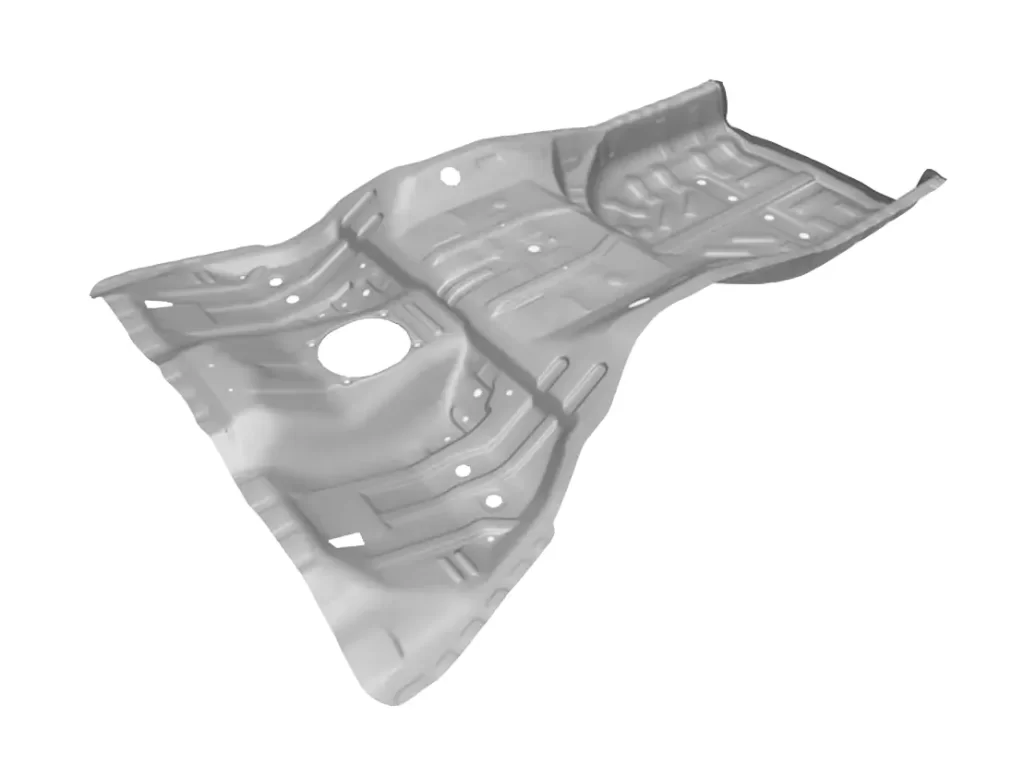
Steel contains a certain amount of solid solution carbon and nitrogen atoms, which contribute to its strength. Strengthening elements like phosphorus and manganese can be added to further increase its strength. Once processed and formed, the steel is baked at a specific temperature, which results in age hardening and a further increase in yield strength. This type of steel is commonly used in the outer coverings of automotive vehicles, and its microstructure is predominantly ferrite.
| Grade | YS(MPa) | TS(MPa) | EL(%) | r | n | BH2(MPa) |
| HC180BD+Z-T | 180-240 | 300-360 | ≥34% | ≥1.5 | ≥0.16 | ≥30 |
Grade: HC180BD+Z-T
C(max): 0.04
Mn(max): 1
Si(max): 0.5
The Rear Longitudinal Center Section is a critical structural component of a car's chassis. It runs along the center of the underside of the vehicle and typically comprises of high-strength steel to support the car's rear end and the forces generated during acceleration, deceleration, and cornering. This part works in conjunction with other components such as the front longitudinal member and cross members to provide rigidity and stability. Furthermore, it is designed to absorb and disperse impact forces in collisions for improved occupant safety.
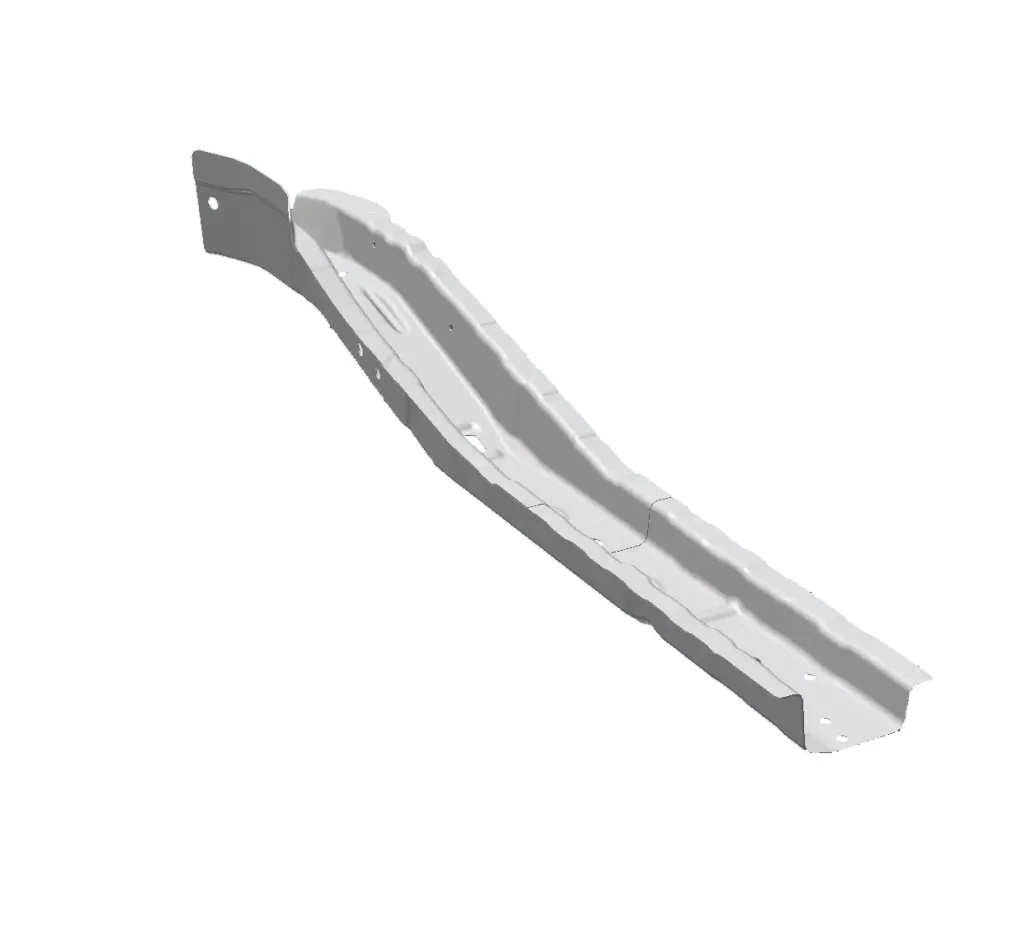
The microstructure of this steel is a combination of ferrite and martensite, with the martensite structure dispersed in the form of islands within the ferrite matrix. This dual-phase structure is highly desirable for automotive structural parts due to its low yield ratio, high work hardening index, and bake hardening value.
| Grade | YS(MPa) | TS(MPa) | EL(%) | r | n | BH2(MPa) |
| HC340/590DPD+Z | 290-370 | ≥500 | ≥27% | - | ≥0.15 | - |
| HC420/780DPD+Z | 420-550 | ≥780 | ≥17% | - | - | - |
Grade: HC340/590DPD+Z
C(max): 0.15
Mn(max): 2.5
Si(max): 0.6
Grade: HC420/780DPD+Z
C(max): 0.18
Mn(max): 2.5
Si(max): 0.8
The Rear Longitudinal Front Section refers to the front section of the rear longitudinal member, a component underneath the vehicle's floor. This member is an essential part of the chassis and aids in transferring loads and forces from the suspension to the body. The Front Section usually connects to the Center and Rear Sections to form a complete framework, which is often made from high-strength steel in order to tolerate diverse pressures. Crucially, it helps guarantee stability and strength for everyday driving and during demanding scenarios - like high-velocity maneuvers or collisions.
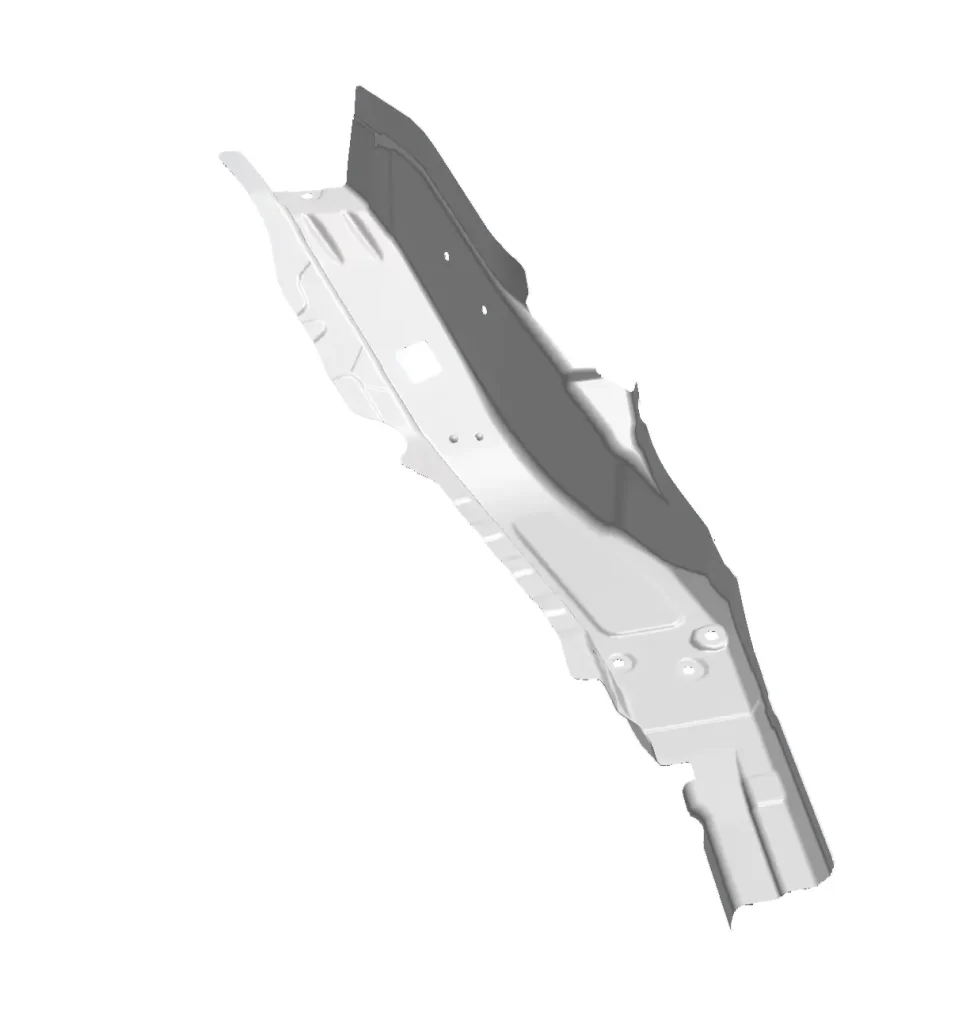
Phase transformation induced plasticity (TRIP) steel consists of a microstructure composed of ferrite, bainite, and retained austenite. During the forming process, the retained austenite undergoes transformation into martensite, leading to an enhancement in the material's plastic deformation ability and resulting in high strength and good plasticity. This material possesses favorable properties such as a high n value, excellent formability, and high impact absorption energy.
| Grade | YS(MPa) | TS(MPa) | EL(%) | r | n | BH2(MPa) |
| HC380/590TR | 380-480 | ≥590 | ≥28% | - | ≥0.2 | - |
Grade: HC380/590TR
C(max): 0.23
Mn(max): 2
Si(max): 1.8
The third crossmember, also known as the third cross brace, is an essential structural element in the underbody of a vehicle. Typically made from steel, this transverse connection point is positioned between the front and rear axles, providing additional support to the chassis to help distribute weight evenly and improve overall stability. It not only enhances handling and performance by reducing body roll during cornering and creating a more rigid platform for the suspension system, but also helps absorb energy from impacts and provide additional protection to passengers in vehicle collisions. Additionally, many underbody components like the exhaust system, fuel tank, and rear suspension are mounted on the third crossmember thanks to its capacity to withstand torsion, bending and compression forces.
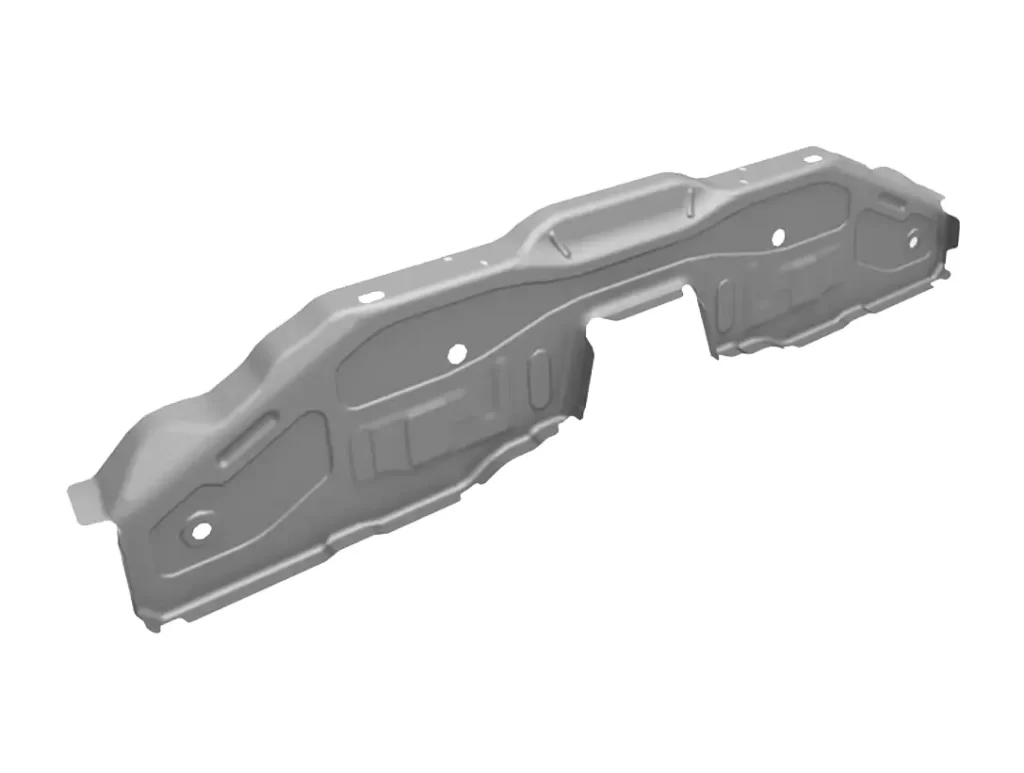
This steel's microstructure consists of ferrite and martensite in a dual-phase arrangement, where the martensite structure is dispersed as islands within the ferrite matrix. This unique structure makes it an ideal choice for automotive structural parts, as it exhibits a low yield ratio, high work hardening index, and an excellent bake hardening value.
| Grade | YS(MPa) | TS(MPa) | EL(%) | r | n | BH2(MPa) |
| HC420/780DPD+Z | 420-550 | ≥780 | ≥17% | - | - | - |
Grade: HC420/780DPD+Z
C(max): 0.18
Mn(max): 2.5
Si(max): 0.8
The fourth crossmember is a structural component of a vehicle's chassis that provides additional support to the underbody structure. It is typically made of high-strength steel and is positioned in the middle of the vehicle's chassis, running from left to right.
As the name suggests, the fourth crossmember is the fourth transverse connection point in the underbody structure of the vehicle, located between the front and rear axles. It is designed to improve the overall strength and rigidity of the vehicle's chassis by distributing the weight of the vehicle evenly.
The fourth crossmember plays an important role in enhancing the vehicle's handling and performance by improving its stability, particularly during high-speed driving and sharp turns. It also helps to absorb and dissipate some of the impact energy in the event of a collision, providing additional protection to the vehicle occupants.
In addition, the fourth crossmember is an important mounting point for various underbody components, such as the exhaust system, fuel tank, and rear suspension. It is designed to withstand a wide range of stresses and forces, including torsion, bending, and compression.
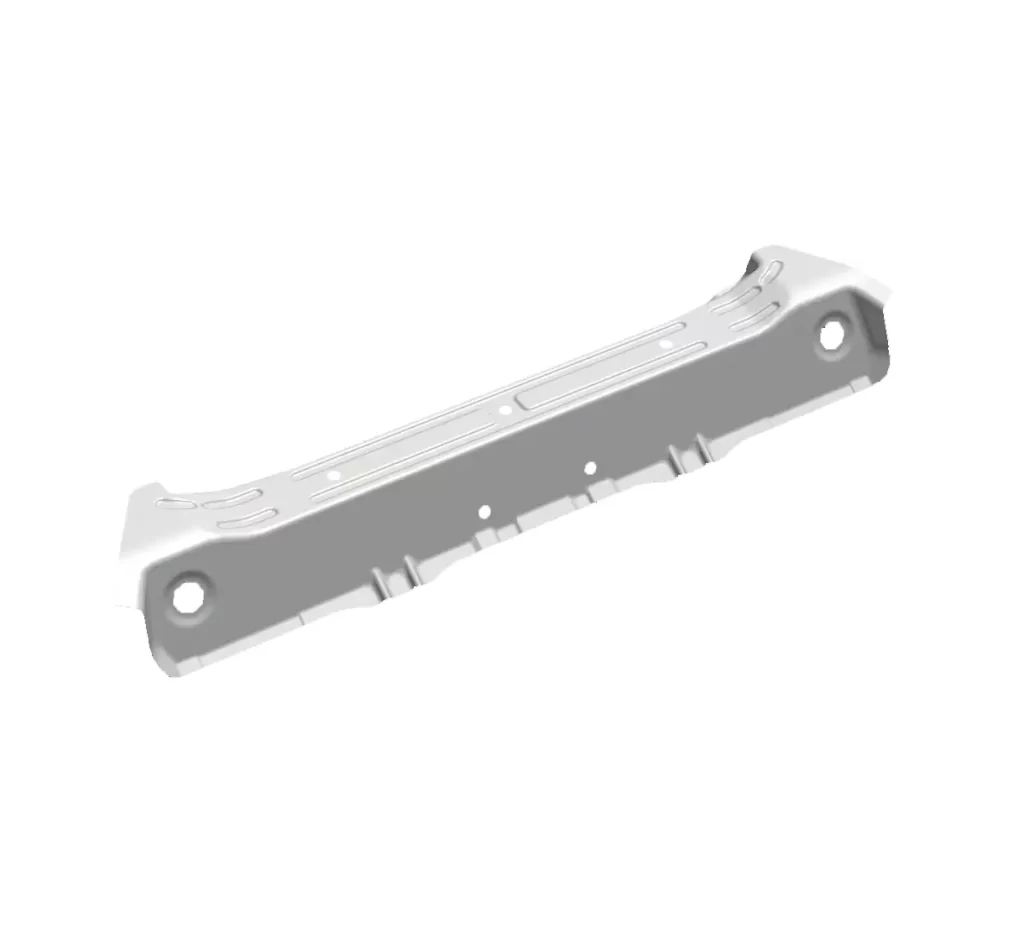
The microstructure of this steel comprises a dual-phase arrangement of ferrite and martensite, where the latter is dispersed as islands within the ferrite matrix. Its distinct structure renders it a top pick for automotive structural components, displaying a low yield ratio, high work hardening index, and exceptional bake hardening value.
| Grade | YS(MPa) | TS(MPa) | EL(%) | r | n | BH2(MPa) |
| HC340/590DP | 340-440 | ≥590 | ≥22% | - | ≥0.14 | - |
Grade: HC340/590DP
C(max): 0.15
Mn(max): 2.5
Si(max): 0.6
The fifth crossmember is an important structural component in a vehicle's underbody structure. It is positioned towards the rear of the vehicle, typically between the rear wheels, and is designed to improve the overall strength and rigidity of the vehicle's chassis.
As the name suggests, the fifth crossmember is the fifth transverse connection point in the underbody structure of the vehicle, located behind the fourth crossmember. It plays a crucial role in distributing the weight of the vehicle evenly and reducing torsional flex, which in turn helps to improve the vehicle's handling and stability.
The fifth crossmember is typically made of high-strength steel or other lightweight yet strong materials to ensure maximum durability and reliability. It is also engineered to be aerodynamic and contribute to the vehicle's overall efficiency and performance.
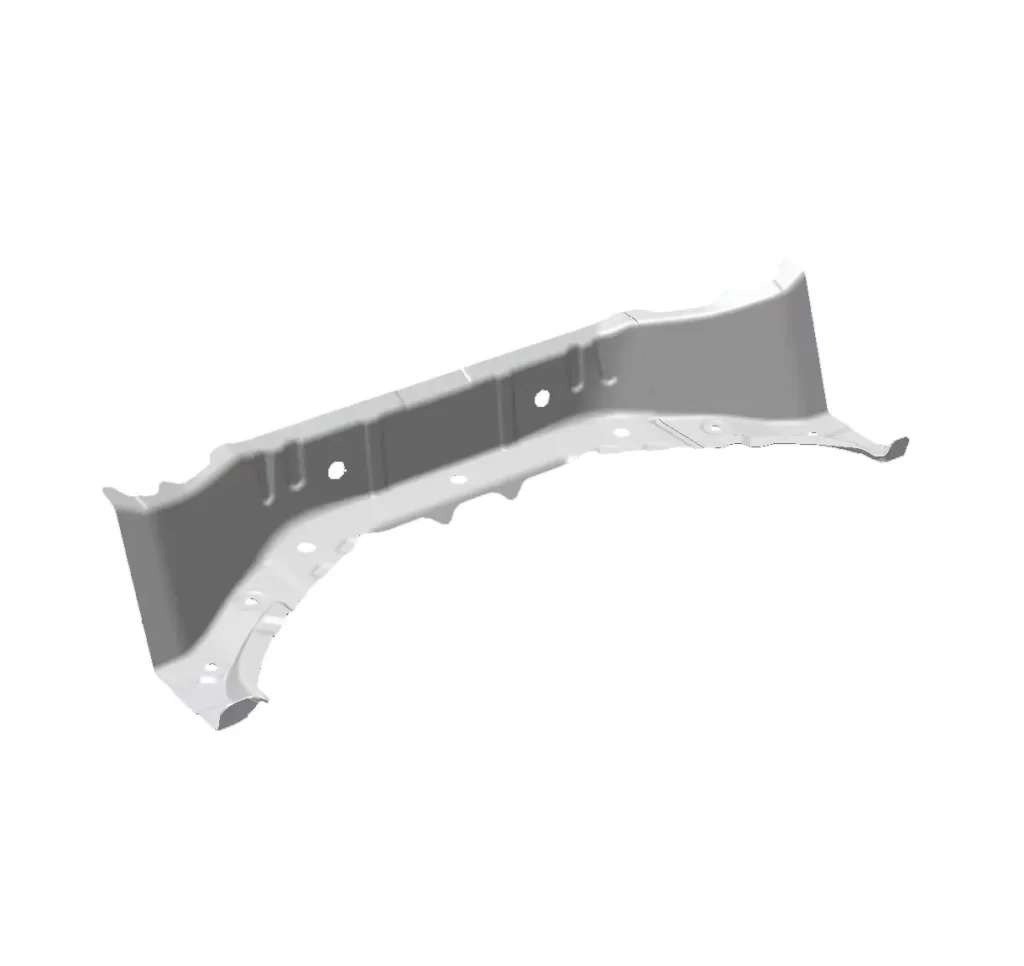
Dual phase steel is a preferred material for automotive structural components due to its microstructure, which mainly comprises of ferrite and martensite. The martensite structure is distributed as islands within the ferrite matrix. excellent bake hardening value, making it an ideal choice for automotive applications.
| Grade | YS(MPa) | TS(MPa) | EL(%) | r | n | BH2(MPa) |
| HC340/590DPD+Z | 290-370 | ≥500 | ≥27% | - | ≥0.15 | - |
Grade: HC340/590DPD+Z
C(max): 0.15
Mn(max): 2.5
Si(max): 0.6
The rear floor pan crossmember is a structural component in a vehicle's underbody structure that connects the rear floor pan to the rear longitudinal frame member or the rear suspension subframe. It is typically made of high-strength steel and is positioned towards the rear of the vehicle.
The primary function of the rear floor pan crossmember is to reinforce the rear floor pan and provide additional support and rigidity to the vehicle's underbody structure. It helps to distribute the weight of the vehicle evenly and reduce torsional flex, which in turn improves the vehicle's handling and stability.
The rear floor pan crossmember plays an important role in enhancing the overall safety and durability of the vehicle. In the event of a collision, it helps to absorb and dissipate some of the impact energy, providing additional protection to the vehicle occupants.
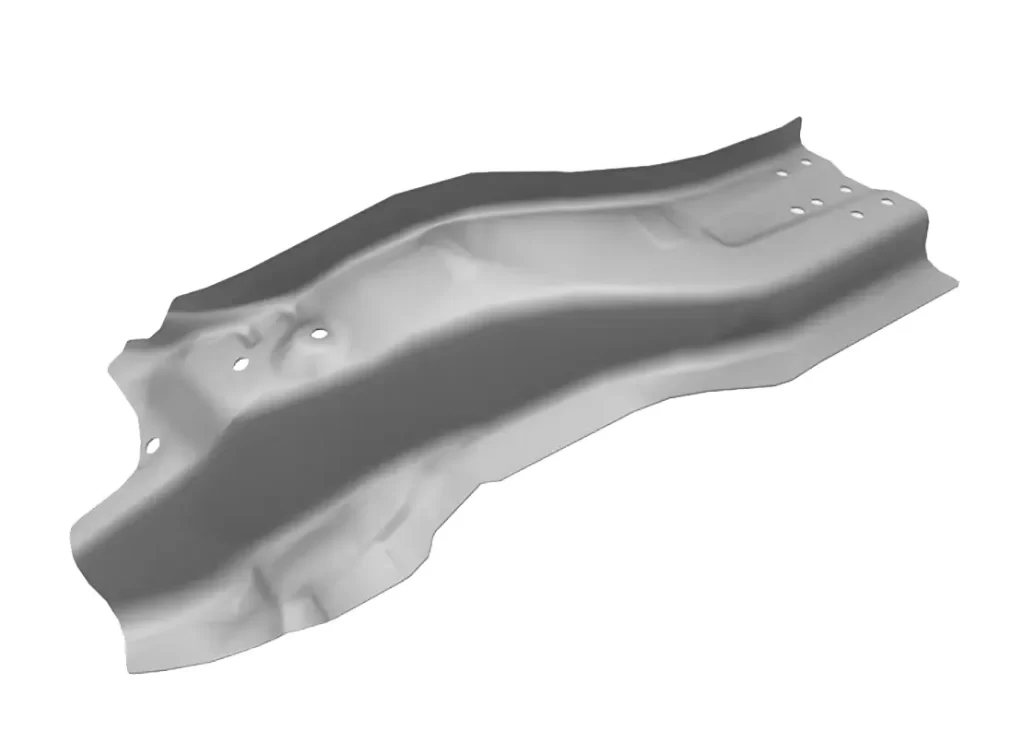
Dual-phase steel is a favored material for structural parts in the automotive industry, owing to its microstructure comprising primarily of ferrite and martensite, with the latter dispersed in the form of islands within the former's matrix. The steel's low yield ratio, high work hardening index, and excellent bake hardening value further enhance its suitability for use in automotive applications.
| Grade | YS(MPa) | TS(MPa) | EL(%) | r | n | BH2(MPa) |
| HC420/780DPD+Z | 420-550 | ≥780 | ≥17% | - | - | - |
Grade: HC420/780DPD+Z
C(max): 0.18
Mn(max): 2.5
Si(max): 0.8
The rear longitudinal frame reinforcement front section is a steel plate that is installed at the front section of a vehicle's rear longitudinal frame. It plays an important role in enhancing the rigidity and stability of the vehicle's body during operation.
The rear longitudinal frame reinforcement front section is a crucial component of a vehicle's underbody structure. It is attached to the front section of the rear longitudinal frame and provides reinforcement and support to the body of the vehicle. It also serves as a mounting point for important components such as the rear suspension and rear floor pan.
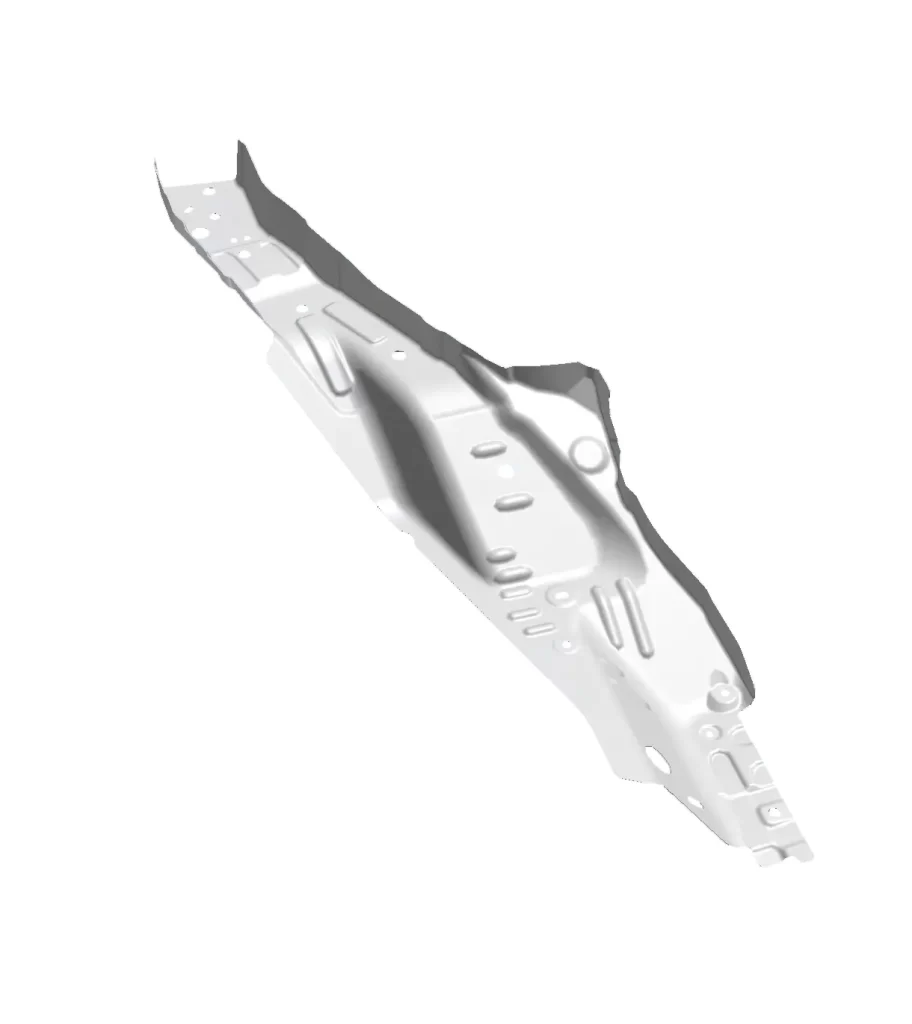
Dual-phase steel is a preferred choice for automotive structural parts due to its microstructure composed primarily of ferrite and martensite, with the martensite structure dispersed in the form of islands within the ferrite matrix. Its low yield ratio, high work hardening index, and excellent bake hardening value further contribute to its suitability for automotive applications.
| Grade | YS(MPa) | TS(MPa) | EL(%) | r | n | BH2(MPa) |
| HC340/590DPD+Z | 290-370 | ≥500 | ≥27% | - | ≥0.15 | - |
Grade: HC340/590DPD+Z
C(max): 0.15
Mn(max): 2.5
Si(max): 0.6
The rear longitudinal frame rear cover is a panel that is installed on the rear section of a vehicle's longitudinal frame. It is designed to protect and cover the rear longitudinal frame, which is a structural component of the vehicle's underbody.
The rear longitudinal frame rear cover is typically made of steel or other durable materials that are resistant to corrosion and impact. It is attached to the rear section of the longitudinal frame and provides protection from debris, rocks, and other objects that may hit the frame during operation.
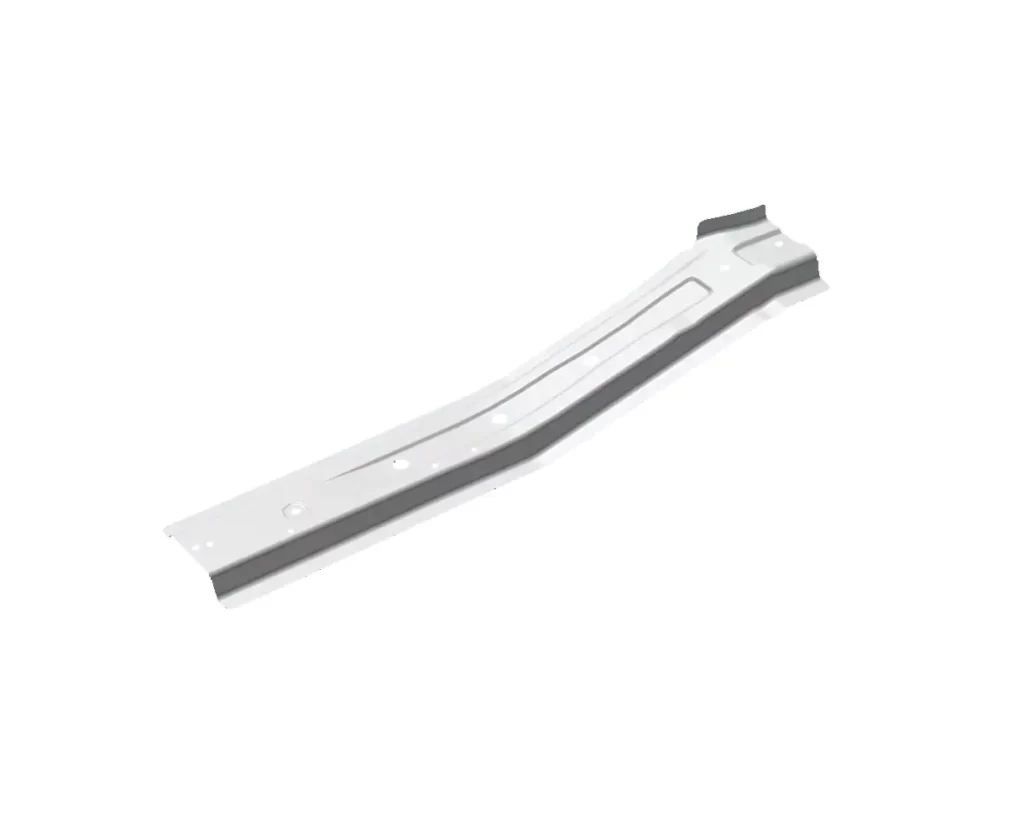
The microstructure of dual-phase steel is predominantly composed of ferrite and martensite, where the latter is dispersed in the form of islands within the former's matrix. This steel is a top preference for automotive structural parts due to its low yield ratio, high work hardening index, and exceptional bake hardening value, which further enhance its suitability for use in the automotive industry.
| Grade | YS(MPa) | TS(MPa) | EL(%) | r | n | BH2(MPa) |
| HC340/590DPD+Z | 290-370 | ≥500 | ≥27% | - | ≥0.15 | - |
Grade: HC340/590DPD+Z
C(max): 0.15
Mn(max): 2.5
Si(max): 0.6
Our company: Hengqiao(Shanghai) International Trading Limited
The company's main business is general GMW standard, Fiat EFE standard, Volvo VDA standard, Nissan NEN standard, Volkswagen VW50065, Ford WSS-M and other standard series of automotive steel.
Looking forward to your inquiry!
632 stainless steel is a type of precipitation-hardening stainless steel that is known for its high strength and excellent corrosion resistance. The precipitation-hardening process involves heating the steel to a specific temperature and holding it there for a certain amount of time, allowing the formation of tiny particles within the metal that give it increased strength and hardness.
632 stainless steel is commonly used in applications that require high strength and corrosion resistance, such as in the aerospace industry for components such as turbine blades, exhaust systems, and structural components. It is also used in the oil and gas industry for parts such as pumps, valves, and wellhead equipment.
| Element% | C | Si | Mn | P | S | Cr | Ni | Mo | Al |
| min | - | - | - | - | - | 14 | 6.5 | 2 | 0.75 |
| max | 0.09 | 1 | 1 | 0.04 | 0.03 | 16 | 7.7 | 3 | 1.5 |
Note: These values are approximate
| Tensile strength | Yield strength | Elongation | Hardness | ||
| 1100-1400 MPa | 1000-1200 MPa | 10-15% | 36-40 HRC | ||
Note: These values are approximate
| Property | Value |
| Density | 7.75 g/cm³ |
| Melting Point | 1380-1420°C |
| Specific Heat | 480 J/kg·K |
| Thermal Conductivity | 16.3 W/m·K |
| Thermal Expansion Coefficient | 10.2 µm/m·K |
Note: These values are approximate
Our company: Hengqiao(Shanghai) International Trading Limited
As a premium supplier of stainless steel, we offer a wide range of grades, sizes and finishes to suit your needs.
Size: according to customer requirements
Standards: GB, ASTM, EN, JIS, etc.
Coil/Tube/Pipe/Sheet/Strip/wire/Bar/Channel
Austenitic type
Ferritic type
Martensitic type
Looking forward to your inquiry!